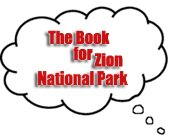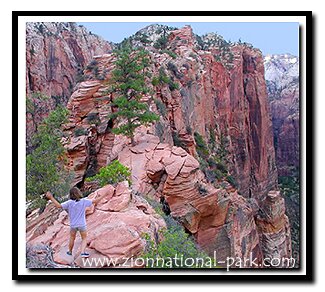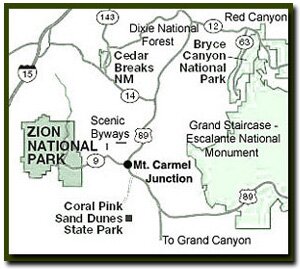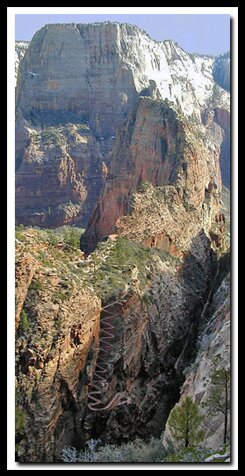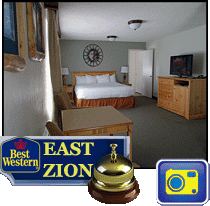
|
||||
|
Zion National Park Lodging Park Info Vacation Weather Photos Hike SR-9 Slots Backpack Camping |
||||
Zion: Angels Landing
|
|||||||||||||
Directions to Zion National ParkFrom the North: Travel I-15 south, past Beaver. exit on Hwy 20. Follow US-89 to Mount Carmel Junction. Take SR-9 to Zion's east entrance.
|
|||
|
|
|||
![]() Angels Landing and the West Rim Trail - From the Grotto Picnic area, cross the Zion Canyon Road. Head toward the footbridge that passes over the North Fork of the Virgin River. On the other side of the bridge, take the north (right) fork to the West Rim Trail. This busy path begins by traveling through a riparian woodland of cottonwood, pinyon pines and junipers. It's a steady 2 mile uphill trek as the trail ascends a series of switchbacks up the steep West Rim Trail. Much of the path hugs the side of the sun baked mountain offering an outstanding vista below of a shimmering river, billowy cottonwood trees and a rich collection of stone. A few ambitious trees are tenaciously growing in cracks high on the sheer cliff, adding bits of green between sections of rock that is stained by iron oxide and desert varnish.
Angels Landing and the West Rim Trail - From the Grotto Picnic area, cross the Zion Canyon Road. Head toward the footbridge that passes over the North Fork of the Virgin River. On the other side of the bridge, take the north (right) fork to the West Rim Trail. This busy path begins by traveling through a riparian woodland of cottonwood, pinyon pines and junipers. It's a steady 2 mile uphill trek as the trail ascends a series of switchbacks up the steep West Rim Trail. Much of the path hugs the side of the sun baked mountain offering an outstanding vista below of a shimmering river, billowy cottonwood trees and a rich collection of stone. A few ambitious trees are tenaciously growing in cracks high on the sheer cliff, adding bits of green between sections of rock that is stained by iron oxide and desert varnish.
Refrigerator Canyon - Just over one mile, hikers get a reprieve from the constant, steep grade of the West Rim Trail and the blazing heat of the full sun. The path turns toward a gap between Angels Landing and Cathedral Mountain. A cool breeze blows through the shady canyon leading to its name - Refrigerator Canyon. In the cooler climate of the ravine, vegetation is more abundant. The white fir is dominant, but it is the only place in the park where this is the case.
Squiggle the Wiggles - Just before the trail spills onto Scout Lookout, it's time to 'squiggle the wiggles,' as they ascend the steep twenty-one sharp zigzags to a scenic plateau. Walter's Wiggles was named after the first superintendent of Zion who helped engineer the steep zigzagging section. The park was in its planning stages at this time and the short, steep section of trail was created to enable horses to access Cabin Spring. One of his granddaughters works in Zion today and his home still stands in Springdale, known now as the Worthington Gallery.
Scout Lookout - The wiggles ascend to a broad, sandy area called Scout Lookout. This is the saddle at the junction of the Angels Landing Trail and the West Rim Trail. The views down into Zion Canyon are impressive. Several climbing routes can be viewed from this vantage point. West Rim Trail continues, past Cabin Spring to Lava Point in the Kolob Terrace section of Zion, but the Angels Landing Trail turns southeast.
Angels Landing Trail - Hikers will navigate the next half-mile along a narrow sandstone isthmus with sheer cliffs on both sides. The narrow and arduous trail drops 1200' on one side and 800' on the other. Chipmunks scurry carelessly along the ridge, finding bits of shade under the few trees that have found a weakness in which to burrow their roots. The summit offers i incomparable, fairytale views. Almost 1500' below, the Virgin River winds around the Organ. The Great White Throne seems only a stones throw away when standing at the end of the trail. Looking northeast across the canyon is Observation Point and to the east is Cable Mountain. Look closely to see the preserved cable-works structure on Cable Mountain. While exploring Zion in 1916, Frederick Fisher exclaimed, "only an angel could land on it," and thus the monolith was named Angels Landing.
Best features of the hike - The last half mile of the trail is fun and the views along the way are impressive. The point at the end of the Angels Landing trail allows for unlimited views of Zion Canyon in both directions and the Great White Throne seems only a jump away. When standing on the peak of Angels Landing the Great White Throne is at eye level. From the top many landmarks of Zion National Park can be seen including the Virgin River, Big Bend, the Organ, Cathedral Mountain, Observation Point and Cable Mountain.
Trail History - A group of four (F. Fisher, V Fischer, E. Bingham, C. Hirshi) were exploring Zion in 1916 when upon looking up at the great monolith, Frederick Fisher exclaimed, "only an angel could land on it." Another name considered for Angels Landing was "El Gobernador," a Spanish term to honor William Spry. Later Spry Mountain was named in his honor instead. The Walter Wiggles section was named after the first superintendent of Zion National Park, who in 1924, helped engineer the twenty-one switchbacks.
Best of Angels Landing - Angels Landing is one of the most famous hikes in the world and it deserves it place with the best. The actual Angels Landing Trail is only a half-mile one way, but it is a spectacular half-mile. The West Rim Trail leading to the Angels Landing Trail is an additional two miles one way. This trail is a rewarding challenge for visitors to the park. Kids should not be taken anywhere there is unsure footing.
Beta: Coordinates and other trail and canyoneering information by Zion Park search and rescue veteran team member Bo Beck and zionnational-park.com author Mary Cisneros.
To post trip reports, offer corrections, updates, or for more information please visit the Zion National Park Forum
Suggested Gear: A sturdy pair of shoes are recommend to hike the trails in Zion National Park. Many quality shoes will help grip the rocks and prevent injury.
|
|
Zion National Park, Utah
History of the Thunderbird
East Zion Lodge
Vacation House
Group Lodging
East Zion Golf
East Zion RV Park
Vacation Packages
Mileage from
Mt. Carmel Jct.
Zion National Park 12
Bryce Canyon 60
Grand Canyon 85
Cedar Breaks 45
Grand Staircase 9
Dixie Forest 22
Sand Dunes 11
Coyote Butte 57
Red Canyon 47
Tuweep 90
Stay in a hotel the heart of the parks, Mount Carmel Junction, and visit the treasures of the Southwest and Utah.
Site Map
Site Map II
Site Map III
Zion Hiking
Zion Park Hiking
Zion Hiking Advanced
Zion Canyoneering
Kolob Hiking
Greater Zion Area
|
|
"I don't know who Mary Cisneros is, but I mean zionnational-park.com
It's a better site than the NPS's anyway."
Written by the authors of the book: Favorite Hikes in and around Zion National Park
|
Zion History |
|---|
All rights reserved © Copyright Zion National-Park dot com
Do not use text, photos or maps without permission © Zion National-Park dot com
Contact the Author Mary Cisneros with any errors

